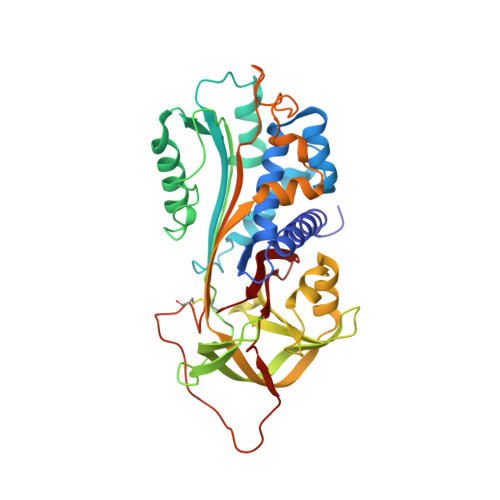Remarkable extension of PAI-1 half-life surprisingly brings no changes to its structure.
Jankun, J., Yang, J., Zheng, H., Han, F.Q., Al-Senaidy, A., Skrzypczak-Jankun, E.(2012) Int J Mol Med 29: 61-64
- PubMed: 21947232
- DOI: https://doi.org/10.3892/ijmm.2011.798
- Primary Citation of Related Structures:
3R4L - PubMed Abstract:
Plasminogen activator inhibitor type 1 (PAI-1) is a serpin protein, a natural inhibitor of urokinase (uPA) and tissue plasminogen activators (tPA). By inhibiting uPA it can block growth of the cancer tumors by suppressing angiogenesis, while when acting on tPA in the blood it can avert conversion of plasminogen to plasmin preventing lysis of the clot. Furthermore, blocking PAI-1 activity can protect against thrombosis. Thus PAI-1 makes great impact on human homeostasis and is desirable for clinical application. Wild-type PAI-1 (wt-PAI-1) has a short span of activity with a t1/2 of ~2 h, being spontaneously converted into a latent form. An enormous effort has been made to create a more stable molecule with >600 PAI-1 variants constructed to study its structure-function relationship. In the present study, we evaluate the structure of the active recombinant VLHL-PAI-1 (very long half life, active >700 h) which is glycosylated similarly to wt-PAI-1 at N232 and N288, with the extended reactive center loop, intact engineered -S-S-bridge (Q174C, G323C) that precludes latency without affecting structure, and can be controlled by a reducing agent to terminate activity at will. We have already proven its usefulness to control cancer in human cancer cells, as well as preventing clot lysis in human whole blood and plasma and in a mouse model. Our results demonstrate the potential therapeutic applications (topical or systemic) of this protein in the treatment of cancer, for the trauma patients to ward off an excessive blood loss, or for people with the PAI-1 deficiency, especially during surgery.
- Urology Research Center, Department of Urology, The University of Toledo, Toledo, OH 43614, USA. jerzy.jankun@utoledo.edu
Organizational Affiliation:


















